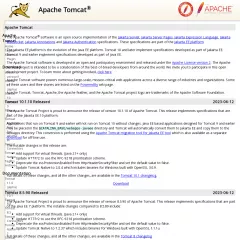Apache Tomcat 
Apache Tomcat is used by 0.13% of sites
Official Website
http://tomcat.apache.orgCategory
Web Servers
Apache Tomcat, commonly referred to as Tomcat, is an open-source web server and servlet container developed by the Apache Software Foundation. It provides a Java-based environment for running Java web applications, specifically Java Servlets, JavaServer Pages (JSP), and Java Expression Language (EL) technology.
Here are some key aspects of Apache Tomcat:
Web Server and Servlet Container: Apache Tomcat functions as a web server and servlet container, serving web content and executing Java web applications. It implements the Java Servlet and JavaServer Pages specifications, allowing developers to build and deploy dynamic web applications using Java technologies.
Java EE Compatibility: Tomcat is designed to be compatible with the Java Enterprise Edition (Java EE) specifications. It supports a subset of the Java EE standards, such as Servlets, JSP, EL, and WebSocket, providing a lightweight and efficient environment for running Java web applications.
Connectors and Protocols: Tomcat supports multiple connectors and protocols to handle incoming requests and communicate with clients. It includes connectors for HTTP, HTTPS, AJP (Apache JServ Protocol), and other protocols, enabling seamless integration with different web servers and proxy servers.
Configuration and Deployment: Tomcat provides a configuration mechanism that allows developers to fine-tune its behavior based on their application requirements. It supports XML-based configuration files and provides a modular structure to manage various components and extensions. Applications can be deployed by packaging them as WAR (Web Application Archive) files or by deploying individual components.
Management and Monitoring: Tomcat includes built-in tools and utilities for managing and monitoring the server. It provides a web-based administration console, known as Tomcat Manager, which allows administrators to deploy, undeploy, and manage web applications. Tomcat also integrates with monitoring tools and frameworks to track performance metrics and troubleshoot issues.
Security: Tomcat offers security features to protect web applications and ensure secure communication. It supports various authentication methods, including form-based authentication, Basic authentication, and digest authentication. It also provides support for SSL/TLS encryption to secure data transmission over HTTPS.
Clustering and High Availability: Tomcat supports clustering to achieve high availability and scalability for web applications. It allows multiple Tomcat instances to work together as a cluster, distributing the workload and providing failover capabilities. Clustering enables load balancing, session replication, and seamless failover in case of server failures.
Extensibility and Integration: Tomcat is highly extensible and provides APIs and hooks for integrating with other technologies and frameworks. It can be extended through custom valves, filters, and servlets, allowing developers to integrate additional functionalities into the server.
Apache Tomcat is widely used for deploying Java web applications, ranging from small-scale projects to enterprise-level applications. Its lightweight nature, simplicity, and compatibility with Java EE standards make it a popular choice among Java developers and organizations looking for a robust and scalable Java-based web server.
Here are some key aspects of Apache Tomcat:
Web Server and Servlet Container: Apache Tomcat functions as a web server and servlet container, serving web content and executing Java web applications. It implements the Java Servlet and JavaServer Pages specifications, allowing developers to build and deploy dynamic web applications using Java technologies.
Java EE Compatibility: Tomcat is designed to be compatible with the Java Enterprise Edition (Java EE) specifications. It supports a subset of the Java EE standards, such as Servlets, JSP, EL, and WebSocket, providing a lightweight and efficient environment for running Java web applications.
Connectors and Protocols: Tomcat supports multiple connectors and protocols to handle incoming requests and communicate with clients. It includes connectors for HTTP, HTTPS, AJP (Apache JServ Protocol), and other protocols, enabling seamless integration with different web servers and proxy servers.
Configuration and Deployment: Tomcat provides a configuration mechanism that allows developers to fine-tune its behavior based on their application requirements. It supports XML-based configuration files and provides a modular structure to manage various components and extensions. Applications can be deployed by packaging them as WAR (Web Application Archive) files or by deploying individual components.
Management and Monitoring: Tomcat includes built-in tools and utilities for managing and monitoring the server. It provides a web-based administration console, known as Tomcat Manager, which allows administrators to deploy, undeploy, and manage web applications. Tomcat also integrates with monitoring tools and frameworks to track performance metrics and troubleshoot issues.
Security: Tomcat offers security features to protect web applications and ensure secure communication. It supports various authentication methods, including form-based authentication, Basic authentication, and digest authentication. It also provides support for SSL/TLS encryption to secure data transmission over HTTPS.
Clustering and High Availability: Tomcat supports clustering to achieve high availability and scalability for web applications. It allows multiple Tomcat instances to work together as a cluster, distributing the workload and providing failover capabilities. Clustering enables load balancing, session replication, and seamless failover in case of server failures.
Extensibility and Integration: Tomcat is highly extensible and provides APIs and hooks for integrating with other technologies and frameworks. It can be extended through custom valves, filters, and servlets, allowing developers to integrate additional functionalities into the server.
Apache Tomcat is widely used for deploying Java web applications, ranging from small-scale projects to enterprise-level applications. Its lightweight nature, simplicity, and compatibility with Java EE standards make it a popular choice among Java developers and organizations looking for a robust and scalable Java-based web server.